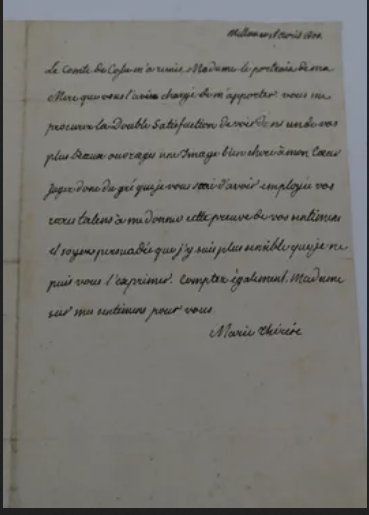 |
| Posthumous portrait of the Queen by Madame Lebrun |
I first visited Marie-Antoinette’s private retreat at Petit Trianon when I was seventeen years old. It was January, but the birds were singing in the gardens. Then and on successive trips, I experienced a strong sense of timelessness. Others have confided to me a similar feeling of enchantment when wandering through the gardens of Trianon.
People frequently ask me why I write about Marie-Antoinette. One of the reasons is that I keep encountering educated people who really think she said, “Let them eat cake.” I continue to encounter Christians who think Marie-Antoinette was killed as punishment for some egregious wickedness or, at least, for unforgivable stupidity. Having read books about her since childhood, I knew she was misunderstood; it was only after a great deal more research that I came to see how completely false are the common beliefs about her.
But the demonization of Marie-Antoinette in the popular mind is necessary to justify the excesses of the French Revolution. When people have a false and distorted view of history, it is difficult for them to grasp the present, and almost impossible to meet the future with any kind of preparedness.
The French Revolution was not necessary, simply because it is never necessary to murder tens of thousands of people. Reform certainly was needed, but reform can happen without mass murder.
Louis XVI was an intrepid reformer. He was not afraid to break with the past and abolish outdated customs while introducing new ways of doing things. Louis was not resistant to change, although that is how he is usually portrayed. The changes were slow but over time might have been effective, had the violent upheavals not swept everything away.
Too often, the violence is represented as a sad but unavoidable means of achieving freedom and democracy. But it is not only that the French Revolution overturned the social order; it was ultimately an attack on the Catholic Church. Many Catholics were killed, especially those peasants who did not want their religion taken away.
The French Revolution has been the blueprint for every totalitarian regime that has followed and has continued to be the model for those wishing not only to destroy the Catholic Church, but all Christian society. (Read more.)
The portrait above was painted posthumously by Madame Lebrun. Here is a letter from Marie-Thérèse Charlotte to the artist, who was a friend of the family:
A letter written by Marie-Thérèse Charlotte to Elisabeth Vigee-Lebrun on April 15th, 1800, regarding a portrait of Marie Antoinette, which was given to Marie-Thérèse by the comte de Cossé. The duchesse wrote that he gave her…
Share“…the portrait of my Mother that you had charged him to bring me. You give me the double satisfaction of seeing in a more beautiful work an image very dear to my heart. Judge therefore how grateful I am to you for having used your rare talents to give me this proof of your feelings and be convinced that I am more sensitive to it than I can express to you. You can count equally, Madame, on my feelings for you.”



















4 comments:
Her story has opened my eyes to see the wicked truth behind something being called "Revolution" that people have been brainwash to romanticized them as cool and turn away from what they decline to accept. Under the cover of liberty, freedom and people's authority there're too many twisted mindset and behind the cool and beauty of saying "Peace" and "Equality" , they are funny with bloodshed and beheading the woman over and over just because she's branded to be people's enemies even though they know about her real story.
That make me feel hopeless to this world everyday.
I thought the portrayal at the Olympics opening ceremony was tasteless, ghoulish and dehumanising. It really shocked me. Those who have gone before us deserve dignity and respect. But then what I saw of that ceremony seemed silly and ill-judged to me.
On the topic of what Marie Antoinette has meant to later ages ... I was wondering if you are familiar with and/or have an opinion on 1) père Dumas' The Knight of Maison Rouge; and 2) Corgliano's The Ghosts of Versailles. Peace.
Camille, there are many now who love Marie-Antoinette and are writing the truth about her.
April, I agree.
crazy, I have never read "The Knight" and I dislike "The Ghosts of Versailles."
Post a Comment